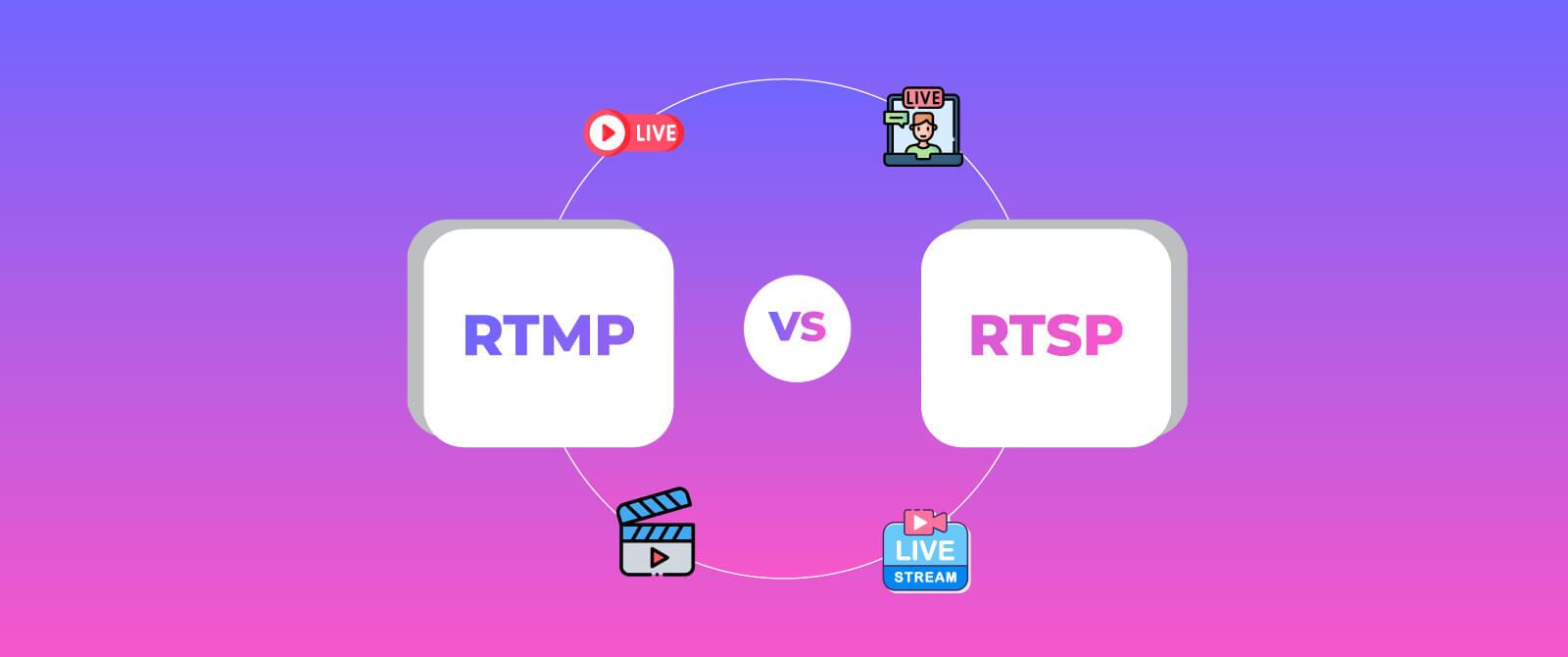If you organize a live stream or virtual event, it needs to be seamless. For online video content, it is crucial to provide high quality. Because providing the audience with the best experience and keeping them engaged is necessary. If they face any kind of difficulties then you might lose them as they can instantly leave the stream. RTMP and RTSP are the two most popular video streaming protocols that are responsible for giving your audience the best experience. However, live video streaming has become popular and requires a proper set-up and without using the right protocol your video content can be compromised.
Moreover, the difference between RTMP vs. RTSP is necessary to consider. Depending on the event, video content, equipment, and needs, one is more likely to be suitable than another. In this blog, we are going to cover both RTMP and RTSP streaming protocol in detail. We will compare their differences and pros and cons so you can decide and choose the best one based on your streaming needs.
What Are Video Streaming Protocols?
Video streaming protocols are standard rules and conventions that transmit video content over the internet. These protocols ensure effective and reliable streaming of content from server to receiver and enable seamless and high-quality video streaming experiences for the audience. Moreover, in the context of streaming these protocols define how the data is packed, transmitted, and decoded throughout the communication. This whole communication can be used in real-time or video-on-demand services.

Moreover, there are various streaming protocols available that cater to different needs. By considering the factors such as latency, adaptability, and compatibility with different devices and networks. Furthermore, there are some widely used examples like RTMP streaming protocol (Real-time messaging protocol). It is being used for live streaming and video on demand streaming and provides seamless connection for low latency streaming. Another example is RTSP streaming protocol (Real-time streaming protocol) which is designed to control the delivery of streaming media. It works in coordination with other protocols such as RTP, and allows users to request specific segments of video content.
Overall, video streaming protocols form the backbone of online video content delivery, ensuring a smooth and reliable viewing experience for audiences across various platforms and devices.
Understanding RTMP vs. RTSP Streaming Protocols
RTMP and RTSP are two widely used streaming protocols that allow audiences to view content from any device and browser. These online streaming protocols have a predefined set of rules that allow data to travel from one communicating device to another. Both are the most common, which is why it is necessary to see the comparison of RTMP vs. RTSP. Since they have a similar goal, however, when compared there are some important differences that need to be looked at.
What is RTMP Streaming Protocol?
RTMP (Real-time messaging protocol) serves as a bridge for transmitting a diverse range of audio and video data between two consecutive channels. RTMP streaming protocol was initially designed to maintain stability between the media server and the device. The two key aspects of this protocol are low latency and reliability, which makes it an exceptionally favoured choice of many streamers, event organizers, and businesses. RTMP enables seamless and instantaneous communication between the server and the end device, making it standard to use when it comes to online streaming.
Furthermore, this video streaming protocol extends beyond audio and video needs, encompassing an array of data types. Making it a versatile solution for an array of interactive content delivery needs. This gives a major reason for RTMP to remain relevant and popular despite the emergence of more new streaming protocols.
Moreover, RTMP streaming protocol works on TCP (transmission control protocol). It sends the smaller data in a static order until they reach the final destination. It is being widely used for ingesting the data, performing streaming, and then transcoding it into HLS for multi-device support. Most streaming platforms like YouTube, Facebook, and more are leveraging RTMP to ensure low latency and stability.
Pros of RTMP
Here are the basic advantages of using RTMP streaming that can be achieved while incorporating it into your video streaming:
Low Latency
RTMP streaming provides exceptional low-latency capabilities, making it an ideal choice for real-time streaming applications. Whether it is used during online gaming scenarios or event live video streaming, immediate interaction and feedback are critical. RTMP streaming protocol ensures minimal delays in delivering content from the server to the audience’s device. This is valuable in enhancing engagement and providing a more immersive and responsive experience during streaming.
Adaptive Bitrate Streaming
RTMP supports adaptive bitrate streaming, which is a crucial advantage during online content delivery. This feature allows the seamless adjustment of video quality based on the audience’s internet connection. Moreover, when network conditions fluctuate, RTMP can easily adapt the bitrate of the streaming content. This ensures a smooth and uninterrupted viewing experience. This capability of RTMP video streaming protocol is valuable in addressing the challenges faced during varying internet speeds, catering to a diverse audience with different connectivity.
Wide Compatibility
RTMP streaming provides broad support across various platforms and devices that significantly contribute to its versatility in delivering content. This compatibility ensures that it can reach a diverse audience, regardless of the devices they use or the platforms they prefer. Its compatibility enhances the experience and acts as a reliable and accessible streaming solution. It is crucial for content creators, event organizers, and service providers looking to maximize audience reach and maintain streaming consistency across different devices.
Here are some cons of using RTMP that must be kept in mind before coming up with a decision to incorporate the protocol.
Cons of RTMP
RTMP streaming protocol is supported by Flash players, a format that is widely used. However, HTML5 players are quickly becoming a modern standard but RTMP cannot play with these players without a converter such as HLS. This streaming protocol requires other tools to function over different players.
Bandwidth Issues
RTMP streaming can be vulnerable to issues of low video bandwidth and can cause frequent frustrating interruptions during video streaming that ruin the experience for attendees.
HTTP Compatibility
Streaming your RTMP video content feed directly to an HTTP connection is not possible. To make it happen, you have to connect to a special server such as Flash Media or use any third-party content delivery network.
What is RTPS Streaming Protocol?
RTSP (Real-time streaming protocol) is a not-so-popular online video streaming protocol. It is crafted for the control and management of video content data delivery over the internet. Unlike RTMP, RTSP streaming protocol does not emphasise real-time communication. But with the idea of controlling the streaming server used for communicating and entertainment systems. Its design excels in overseeing the delivery of the content and offers a distinct approach to multimedia streaming.
RTSP streaming servers are established right in the middle of the audience and live streaming to issue the controlling commands when needed. It does not prioritize low latency and real-time interactions. Moreover, this video streaming protocol functions as a communication protocol that aids in the efficient transfer of audio and video content between two channels. This makes it suited for streams where managing and coordinating is crucial rather than immediate responsiveness.
Furthermore, to maintain the consistency and smoothness of video streams, RTSP incorporates protocols like TCP and UDP for delivering content in other formats. Because of this, audiences are able to seamlessly play and download video content on their devices. For simpler understanding, RTSP streaming protocol operates through a client-server model where users can initiate commands like pause, play, or stop. This allows the audience greater control over the streaming experience in an interactive way.
Pros of RTPS
Here are some of the greater advantages of using this enhanced streaming protocol to host seamless video streams.
Protocol Flexibility
One of the key aspects of RTSP is its remarkable protocol flexibility. This empowers RTSP to seamlessly integrate with a diverse range of codecs and media formats. This flexibility gives significant advantages, especially when video content is being created and consumed in various formats. By accommodating different protocols, RTSP ensures compatibility with a wide range of devices and platforms. It allows content creators and service providers to choose the most suitable formats for their specific needs without compromising the streaming quality.
Multi-Stream Support
RTSP can support multiple streams, making it exceptionally well-suited for applications that demand simultaneous streaming of diverse content. This capability is particularly valuable in scenarios where creators aim to provide viewers with different perspectives, such as multiple camera angles during live streaming events. RTSP streaming protocol’s ability to handle multiple streams enhances the overall streaming experience, contributing to a more immersive and engaging attendee interaction.
Scalability
Scalability is another notable advantage of RTSP, making it an optimal choice for large-scale and complex streaming scenarios. Whether providing streaming services across expansive networks or integrating multiple cameras, RTSP’s scalability ensures a seamless and efficient experience. The protocol allows for the expansion of streaming capabilities without compromising performance. This makes it well-suited for video streaming where scalability is a critical consideration.
Cons of RTSP
Along with positives there are always some negatives, here are some cons of RTPS streaming protocol that should not be neglected.
Higher Latency
One significant drawback associated with RTSP streaming is its tendency to exhibit higher latency. When compared to the low-latency capabilities of protocols like RTMP it can be a limiting factor. Particularly during streamings that require real-time interaction and immediate responsiveness. The delay in content delivery may become more noticeable during live streaming of events or online gaming.
Limited Compatibility
Despite its support across various platforms, RTSP streaming protocol may encounter compatibility issues. This limitation can impact the seamless delivery of multimedia content, impacting the user experience. Compatibility challenges may arise due to variations in how different devices interpret and handle content. RTSP’s flexibility allows it to integrate with various codecs and media formats, ensuring broad compatibility. Occasional issues with specific devices or platforms can be a concern.
Less Popularity
When compared to other media streaming protocols, RTSP is not so popular. Most of the video streaming platforms and services do not support RTSP streaming protocol, making it difficult to broadcast the content on a web browser. For broadcasting an RTSP stream, you need to use a separate live streaming service along with other considerations.
Final Thoughts
Understanding the difference between RTMP vs. RTSP streaming is important to understand which is better according to the video content needs and preferences. Both of these video streaming protocols are great but work differently based on their individual characteristics. Choosing the right protocol is crucial for a seamless experience whether you are live streaming, broadcasting, or hosting any event. If you are looking to organize an event then, Dreamcast can provide you with enhanced solutions for live streaming, virtual platform, or any other streaming experience. With end-to-end customization and tailored integrations you can organize seamless events.







